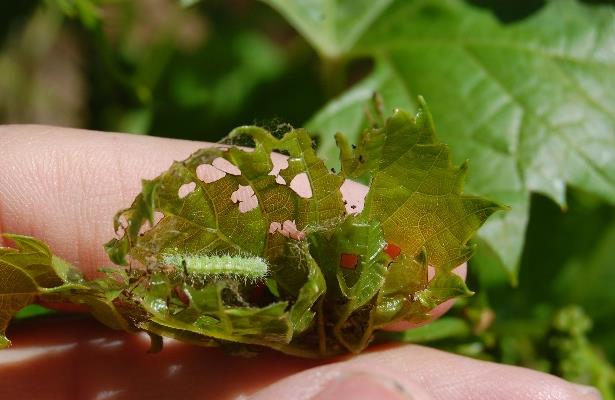Grape Plume Moth

Grape plume moth is a sporadic pest of grapes in the Midwest, and has been seen in rather high numbers for the past couple weeks at the West Madison Agricultural Research Station, and at other local vineyards. Larvae can be easily spotted because they web together the terminal leaves on a shoot, so that they can feed protected between the leaves. Peak infestations in southern Wisconsin occurred over the past couple weeks, and will probably occur in northern Wisconsin in the next week or so. Although many larvae may be present, the vines generally regrow fairly well, and grape plume moth rarely reaches an economic threshold.
Identification: Larvae are light green with long white hairs (see photo above), and reach about ¾ inch before pupating. They are most easily identified by looking for the characteristic webbed up leaves on the tip of the grape vine (see photo below); however, these webbed areas should always be opened up and checked for the caterpillar, as other pests can cause similar webbing in grapes. The adults are brown and white striped, with a feathery look to them.

Biology: Grape plume moths overwinter as pupae in the ground below vineyards. Adults emerge in the early spring and lay eggs on vines. When they hatch, the caterpillars feed on the upper surface of grape leaves, and sometimes on the terminal bud. Occasionally, feeding occurs on flower buds as well, which may directly reduce yield. The caterpillars will then drop off the leaves and burrow underground to pupate by mid-summer. There is only one generation per year, so pupae survive for most of the summer, the fall and the winter before emerging into an adult moth the following early spring.
Monitoring: Monitoring should focus on the perimeter rows nearest to woodlands, where grape plume moth is likely to show up in greatest numbers. The caterpillars may begin to appear in late spring, and will have pupated by the time the fruit is setting.
Control: Generally grape plume moth does not cause enough damage to require control. Research has shown that vines with up to 20% infested shoots do not show reduced yield (Cornell). However, for small scale growers, a simple cultural control is to simply remove the affected leaves and caterpillars. If you experience an especially severe infestation, Danitol and Pyganic should provide control of grape plume moth. Other products registered for grape berry moth should also be efficacious on grape plume moth.
Happy growing season!
This article was posted in Insects and tagged Christelle Guédot, grape plume moth, Grapes, insects, Janet van Zoeren.
